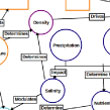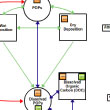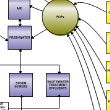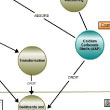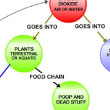 |
|
| SEARCH | PRINCIPLE 2D | ||||||||||||||
|
Climate Literacy Principle 2D: The abundance of greenhouse gases in the atmosphere is controlled by biogeochemical cycles that continually move these components between their ocean, land, life, and atmosphere reservoirs. The abundance of carbon in the atmosphere is reduced through seafloor accumulation of marine sediments and accumulation of plant biomass and is increased through deforestation and the burning of fossil fuels as well as through other processes.
Save map to CMB: Scientist Map | Consensus Map In the original "For Educators" map Dr. Roesler put the broad topics in boxes on the left. The map is also color coded: planetary concepts are yellow, physical constraints are orange, etc. Moving down from upper left demonstrates how changes in environmental gradients will affect biodiversity. Dr. Roesler states, “We don't know how climate change will affect future environmental complexity. But we do know that if the environment changes faster than organisms can adapt, biodiversity will decrease.” As a team, the educators and Dr. Roesler created a consensus map. They focused on how human activity is increasing carbon dioxide and temperature, both of which affect ocean acidity and some organisms' growth rates. Where Do POPs Come From and Where Do They Go in the Coastal Environment? Penny Vlahos (scientist), and educators Karen Beitler, Peter Bertash, and Grace Jacobson Save map to CMB: Scientist Map | Consensus Map Dr. Vlahos’ initial map for educators focused on how Persistent Organic Pollutants (POPs) behave and move through the atmosphere, ocean and the biosphere. On her "To Educators" map, color-coding showed how these compounds are pulled out of global circulation. The education team decided to refocus the map to help students and teachers understand where POPs come from in our society, and to show how these compounds travel through the coastal environment. The revised map doesn't show the entire life cycle of POPs, but Dr. Vlahos’ thinks it is more accessible to middle and high school students, and is now set in a familiar framework! How is Carbon Dioxide Removed from the Atmosphere and Stored for a Long Time in Soils and Sediments? Lawrence Mayer (scientist) and students Zachary Helm, Mahima Jaini, and Peter Stetson Save map to CMB: Scientist Map | Consensus Map Dr. Mayer’s original focus question was "How is Carbon Dioxide (CO2) Taken from the Atmosphere and Put into the Ocean Sediments by Biological and Geological Processes?" His original map had a geographical element. Fellow scientists offered him helpful comments on how to better reach a high school student audience. In his presentation to graduate students he emphasized how CO2 relates to climate change. After discussing the map with graduate students, they came up with a demonstration that would help high school students better comprehend the time CO2 spends in different reservoirs. They reworded the focus question and reshaped the map to illustrate the small amount of time CO2 spends in the atmosphere in comparison to the time it spends in sediments. |
|
|||||||

